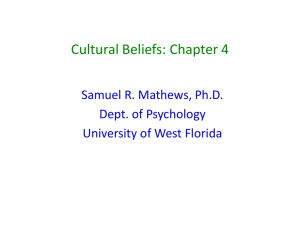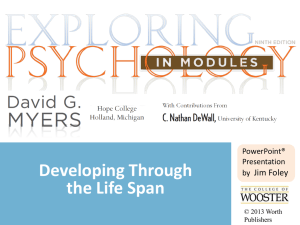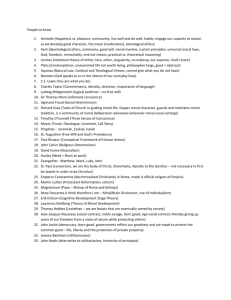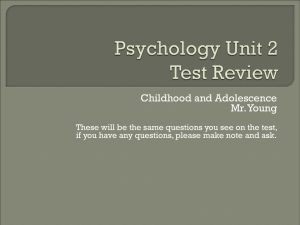Layered Curriculum Lesson Plan Form
advertisement
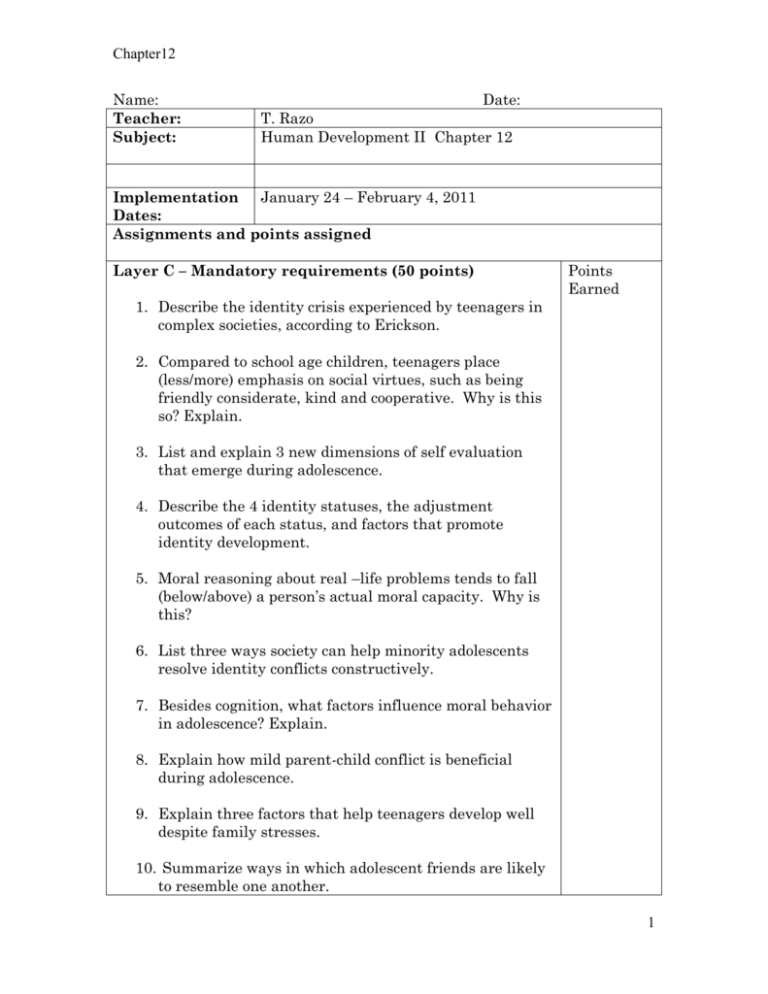
Chapter12 Name: Teacher: Subject: Date: T. Razo Human Development II Chapter 12 Implementation January 24 – February 4, 2011 Dates: Assignments and points assigned Layer C – Mandatory requirements (50 points) Points Earned 1. Describe the identity crisis experienced by teenagers in complex societies, according to Erickson. 2. Compared to school age children, teenagers place (less/more) emphasis on social virtues, such as being friendly considerate, kind and cooperative. Why is this so? Explain. 3. List and explain 3 new dimensions of self evaluation that emerge during adolescence. 4. Describe the 4 identity statuses, the adjustment outcomes of each status, and factors that promote identity development. 5. Moral reasoning about real –life problems tends to fall (below/above) a person’s actual moral capacity. Why is this? 6. List three ways society can help minority adolescents resolve identity conflicts constructively. 7. Besides cognition, what factors influence moral behavior in adolescence? Explain. 8. Explain how mild parent-child conflict is beneficial during adolescence. 9. Explain three factors that help teenagers develop well despite family stresses. 10. Summarize ways in which adolescent friends are likely to resemble one another. 1 Chapter12 11. Describe the function of mixed-sex cliques in early adolescence. 12. Biological changes associated with puberty (can/cannot) account for sex difference in depression. Explain your answer. 13. Describe family characteristics and life events associated with adolescent suicide. 14. Explain why delinquency rises during early adolescence, remains high in middle adolescence and then declines in young adulthood. Layer B - (10 points ea) Choose two Does your identity status vary across the domains of sexuality, close relationships, vocation, religious beliefs, and political values? Describe factors that may have influenced your identity development in an important domain. (pp. 403– 405) How might the exploration of values and goals associated with healthy identity development contribute to the eventual decline in adolescent gender intensification? (pp. 414–415) Thirteen-year-old Mattie’s parents are warm, firm in their expectations, and consistent in monitoring her activities. At school, Mattie met some girls who want her to tell her parents she’s going to a friend’s house and then, instead, join them at the beach for a party. Is Mattie likely to comply? Explain. (p. 421) Why are adolescent girls at greater risk for depression and adolescent boys at greater risk for suicide? (pp. 422–423) Zeke had been well-behaved in elementary school, but at age 13, he started spending time with the “wrong crowd.” At age 16, he was arrested for property damage. Is Zeke likely to become a long-term offender? Why or why not? (p. 425) Layer A – (20 pts) Choose one Visit the website: www.haverford.edu/psych/ddavis/p109g/kohlberg.dilemmas.h tml, which presents four moral dilemmas and a series of 2 Chapter12 questions. select two dilemmas, answer the questions, and evaluate their level of moral reasoning on the basis of research in the text. Next, select a moral dilemma and ask a friend, roommate, or family member to read it and respond to the questions. Classify that individual’s level of moral reasoning. Assessing Moral Reasoning (pp. 407–409) How did family experiences influence your crowd membership in high school? How did your crowd membership influence your behavior? Give examples and situations that came up in your life to explain and support your answers. (pp. 419–420) Reread the sections on adolescent pregnancy and substance abuse in Chapter 11. What factors do these problems have in common with suicide and delinquency? (pp. 422–425) A = 90 B = 80 – 89 C = 70 – 79 D = 60 – 69 F = 59 – below 3
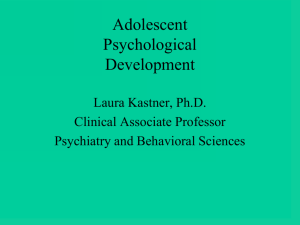


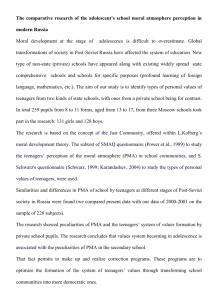
![Adolescence in 20th Century Literature and Culture [DOCX 16.08KB]](http://s3.studylib.net/store/data/006806148_1-4fb552dd69cbfa44b08b2f880802b1fe-300x300.png)


